
Subscribe to continue reading
Subscribe to get access to the rest of this post and other subscriber-only content.


Subscribe to get access to the rest of this post and other subscriber-only content.

Subscribe to get access to the rest of this post and other subscriber-only content.
Still lifes are not particularly exciting for me to paint – though I paint them. Painting still lifes is good practice, however, because of the varying shapes, textures and colors involved, along with the challenge of complex composition. Painting still lifes actually helps in painting portraits. In fact, painting in any style assist with painting any other style. You can look at this painting and see all the separate elements I had to paint. There were decisions and layers of brush strokes involved with each item.
I’m working up to the 10,000 paintings said to be necessary before one can expect to claim “mastery” in oil painting. I’m still under 1000 paintings, so I have a ways to go. It’s time for another portrait. Have a wonderful weekend. Winifred
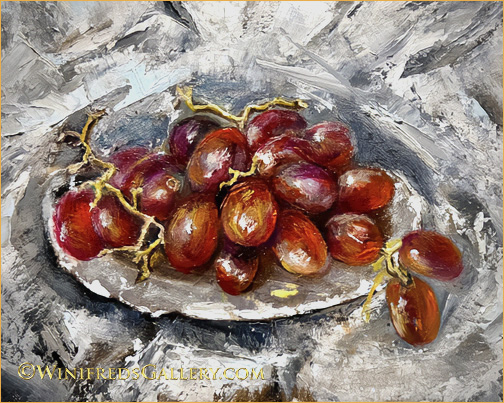
What a journey this painting has had. It was intended as a little practice exercise – to paint something I would not particularly care about. To allow that the painting would not be “precious” as they say, allows one to be more comfortable experimenting – such that what or how one paints just doesn’t matter. So that was my mindset which carried throughout the painting process – as you will see. Below is the reference image – a little yellow plate with grapes on a brown surface.
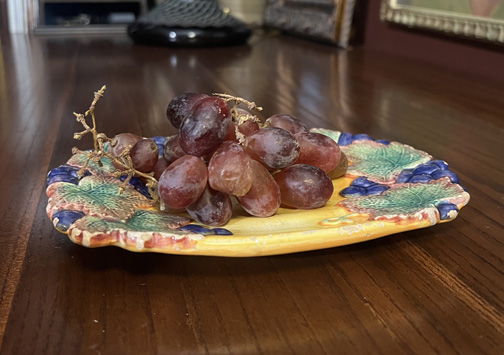
Below is a crop from my initial painting of the plate and grapes.
When I stood back to look, it was apparent I was doing my same old realism and I didn’t want to do that. So, I scraped the paint off the plate. I think it’s rather pretty but I wanted something different from just pretty. It’s getting less hard for me to to paint something relatively well (the plate) and then decide – NO – scrape it off and try again. I maintained the grapes throughout. Below was the next attempt.
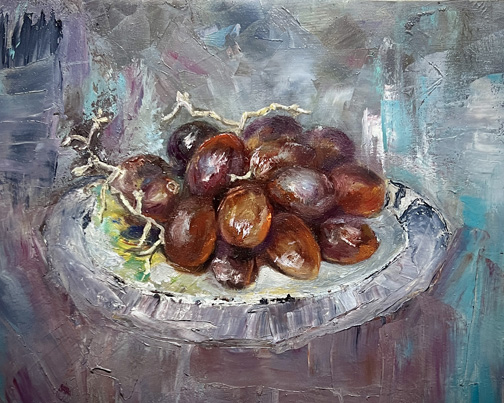
Above, I painted over plate and the background and started adding random colors. Again, I decided NO and scraped off the paint. Then I decided I would approach it differently. I would find my little yellow plate and set up what would be a background and table covering and work from this structure. Below is that photo of what would be my background reference image:
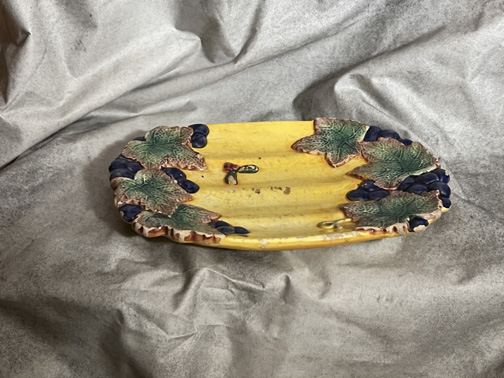
Above: I thought that having this reference would assist me with what I wanted to accomplish. I found a piece of stiff cloth I like to use because it will hold stiff folds. It’s actually a piece of house painters floor protective covering which has vinyl on one side. I set the little yellow plate on it – no grapes – and I photographed the plate against the cloth which gave me a reference background and table covering. Below was my first attempt using the reference to form my background.
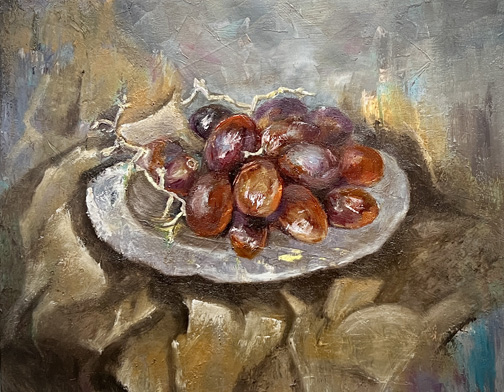
Above: Rather interesting colors and shapes but not what I wanted. Here again, the plate shape is painted with a sense of realism reflecting of the original shape than I wanted, if not the color. Thus, I’m heading down the wrong path again. I struggle with this. Below, I try again.
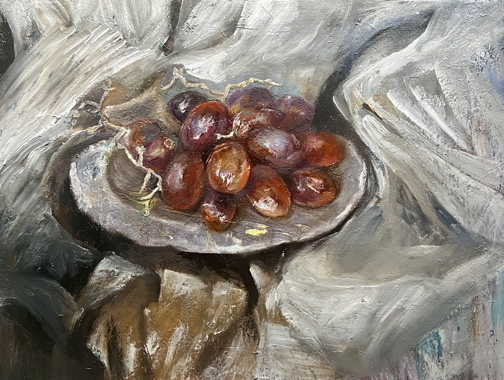
Above: Not so bad except that the color turned to mud because I hadn’t sufficiently dried nor scraped off the tan/gold paint you see before it. This time I would allow it to dry over night and reapply cooler paint colors during my next paint session. Below- the final PERHAPS.

In actuality, the light colors in this painting are very neutral – not so warm hued as they appear in this photo of the painting. (It could just be my screen.) I intensified the grape color, added deeper reds to the grapes and added a couple additional grapes as I always enjoy doing. I admit I never took the grape stems too seriously. I succeeded in a looser background with lots of texture, random abstract strokes and lots of energy. The background is not necessarily pretty but it’s not BORING. That’s important to me. To have energy and not to be boring was my only objective for this little exercise – which turned out NOT to be such a “little” exercise. In keeping with the intention to not make this painting “precious”, I’m going to sand down the background as soon as this painting dries more. I have found that the result of sanding a painting during the painting process or after, most often enhances the painting. It allows some of the underlying colors to come through and it affects the edges in some way. I expect it to become more interesting. I’m not sure what will happen. If the results are particularly interesting I will show you. If you actually made it this far – thank you for sharing this journey with me. Winifred
I’m going to explain what I’ve been doing. It’s been fun. I can’t use solvents in my studio and the use of solvent in oil painting is part of the traditional painting process. It’s used for brush cleaning, to create a thin wash to work out the values of the painting or to paint the first layer with a thin wash of color and to thin oil paint throughout to one’s desired consistency. Mixed with oil paint, the paint dries faster. Sometimes a solid layer of the mid color of the painting is applied overall to the surface and shapes are wiped out to create initial shapes in the painting.
for these reasons, I feel a little handicapped in not being able to use solvent. Many people can’t use it. There can be an allergic reaction which causes head aches, nausea or whatever. The adverse reaction can develop over time. Some of these products are odorless – which I think is a terrible thing. You can’t even tell if solvent is building up in the studio. Without going too far into this. I heard someone mention an alternative. The suggestion came from a very experienced oil painter who post lots of technical info on YouTube. He said †hat for quite a while now, he has used a watercolor wash as a background or first painting layer. Originally he used Acrylic. It “dries” quickly, but the fact is it should cure for 1 to 2 days before painting on it in oil, so he changed to watercolor. So, I decided to try watercolor A normal person would likely have tested this process using watercolor from a set they may have at home, or might purchase inexpensively on Amazon. Not being a normal person, I decided I would make a set of watercolor colors – specific to what I might use for subdued background colors. I probably looked at 30 YouTube videos to learn how to make a watercolor binder. The process is more complicated and requires more ingredients than in making oil paint which I’ve made for years. The other thing is that after grinding the watercolor it has to dry which can take 2 to 3 days curing before using the product. I guess you don’t have. to let it dry but its harder to control the amount on the brush if it’s wet. I initially thought I would make 3 colors. however, I made 12. I couldn’t help it. I had the pigments already and in fact, I had all the ingredients I needed – gum Arabic, glycerin, honey, and clove oil. There are many recipes which can affect the functionality and artistry of watercolor. It’s been fun to learn about which is why I couldn’t get a painting done last week. I spent days studying, and days making the watercolor. I could have gone a much simpler route but I really enjoy making stuff. For my purpose they’re fine. Whether or not they’re really any good – I have no ideabut they will work for me.
Then I selected a painting to test my new watercolor as a background and an initial wash.The painting was interesting to copy. It’s not really a copy but I certainly copied many of the elements from the painters work. I like the fact that I used bristle brushes only. I don’t think I’ve ever done that before. In addition to creating texture which I love, it keeps all the edges soft. I’ll have to try that with a portrait. Actually, I did use a small sable for those delicate little champagne grapes. I then added a border and allowed a couple pieces of fruit to roll out the frame – something I like to do – most often with grapes.
Professional WC is most often in very small containers. My watercolors are large allowing me to insert a large brush into the containers for large strokes rather than small sable brushes most often used in WC painting. Notice my name is not on the painting. I don’t think the artist would like his name on it either. Well, that’s my story. Have a great weekend. Winifred
Unlike with most flowers, I’ve always enjoyed the many phases of life of the sunflower and I have paintings which reflect this. However, I didn’t have a painting quite like this. While going through my files this past week, I came upon this reference photo – I knew instantly I had to paint it. I’m not sure you can tell exactly what it is. It’s actually two large overlapping sunflower heads. All the petals have fallen off and it’s large sunflower seeds have begun to dry. I love the “curls” and the way the light is hitting the dramatic shapes. At 16 x12 , this painting is relatively large and has tremendous visual impact and presence.
I hope you enjoy it. Have a wonderful weekend. Winifred
A couple weeks ago a friend gave me a large beautiful bouquet of peonies from her garden. There were pink peonies with a light yellow centers and even larger white ruffly peonies. I began photographing them right away. I knew I would select a reference image from them one day, when I wanted a very complex and difficult image to paint. I continued to photograph the peonies as the petals wilted and the bouquet grew smaller. The pink flowers with yellow centers wilted first, days later, the white ruffly ones lost their petals. Thereafter, only white buds remained until one of the buds, began to unfold as a small flower. The buds and young flower were originally white but I wanted a different look and feel hence painted them pink and lavender colors and added the small decorative pitcher.
The peonies have all faded now – until they come again next spring. I am happy I captured the many stages of their life in photographic files, in addition to these two oil paintings as memories.
The painting below reflects the last of the larger white peonies and some of the remaining buds. (The pink flowers with yellow centers are not represented in these paintings).
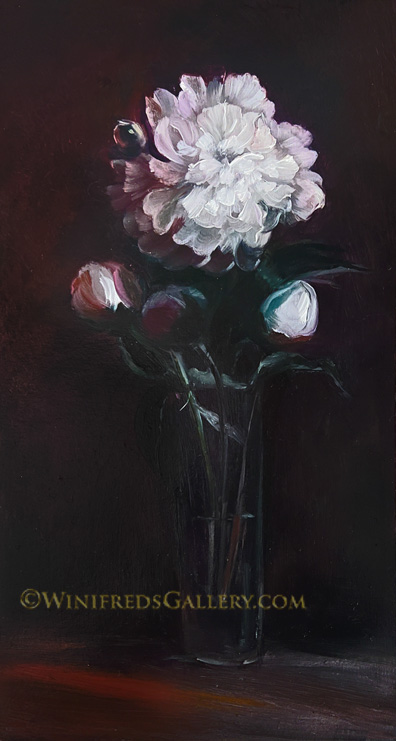
Years ago I created a highly textured panel. I toned it with a burnt orange color and then dripped a solvent on it – just playing and experimenting. I added some brushstrokes and ultimately ended up with something that looked like two fluffy orange peonies in a vase. I thought it pretty fun. Then one day while daisies were in bloom, I put a couple stems in a modern day champagne glass to paint them. Again, I chose a very textured panel to paint on. I decided the orange on orange painting would make a great background for the daisies. So, here we are with texture on texture. I enjoy the warmth and the light as well as painting daisies. I’m not sure why I haven’t painted tulips yet with so many currently blooming in my garden. I think it’s because I have a hard time cutting flowers in bloom.
As it sometimes turns out, I wasn’t very happy with my “2 Apples and 2 Bricks” painting I posted last week – but it’s not one I’ll continue to work on. I’ll never photograph items that have parallel lines with a camera phone again. One apple, however looked edible!
My power has gone off 3 times during the last 2 days. It’s the wind. This has greatly interrupted my work flow though my phone has kept me entertained. Have a wonderful week. Winifred
I so enjoyed painting this still life. Painting grapes is so different from painting eyes and the luscious colors were invigorating. Once done and pleased, I decided to paint a similar image in a different painting style. With the second painting I wouldn’t have to be careful. It is suggested that one not be too “precious” when painting anyhow. It subdues aliveness from ones brush strokes. Below, you can see that I in no way considered the painting precious – just fun.
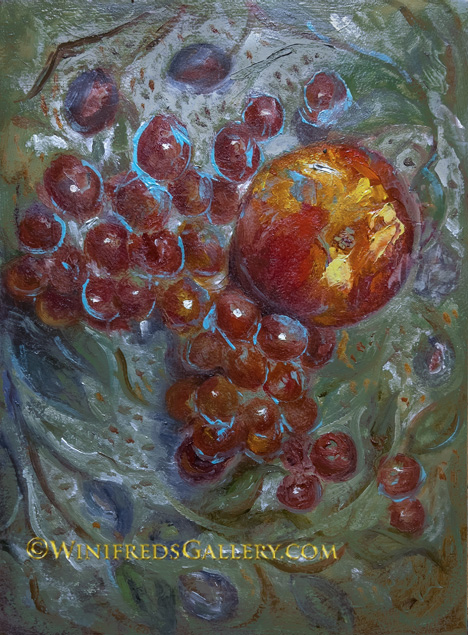
The second painting was actually more difficult to paint than the first. I enjoy its lively brush strokes but it can be scary. For the first painting, I relied on the reference image for content. In the second painting I had to be more imaginative. I remember the moment I decided to circle the grapes with a vivid blue line and decided to add some random dots all over. I like the colors and the additional texture. I hesitated, but then thought I had nothing to lose – my “precious” painting was finished. I have to overcome fear with each irregular and expressive brushstroke.The underlying thought is constantly “I might mess up”. For sure, that is likely to be the case but it doesn’t matter. The inner dialogue can be exhausting. It slows me down but doesn’t stop me. I am sure you can imagine how difficult and stressful it must be to go through this when painting a portrait. Overall, it was a fun week of adventure in painting.
This coming week, I’ll be back to portraits. Have a great weekend. Winifred
Three Vases Still Life – Oil on Linen Panel 12×12
I’m always amazed at how much I enjoy monotone paintings and the depth which can be created in the process. This combined with dramatic light, loose strokes and thick paint seeks to bring this painting alive. I hope you enjoy. Winifred